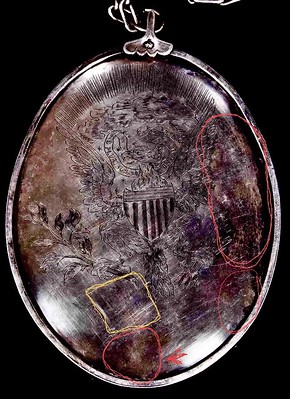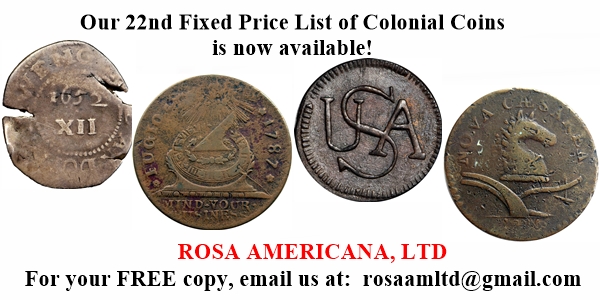
PREV ARTICLE
NEXT ARTICLE
FULL ISSUE
PREV FULL ISSUE
V25 2022 INDEX E-SYLUM ARCHIVE MORE ON THAT 1792 INDIAN PEACE MEDALSorry for the delay in publishing this note from reader Dave Fegley regarding a medal briefly discussed earlier. I ran out of time to handle it last week. -Editor Some thoughts on the 1792 dated oval GW medal sold by Thomaston Place Auction Galleries.... At first glance the medal does not necessarily match the script layout of known authentic medals. Nor does the suspension device. It may be possible to identify the punchmark on the attached suspension ring to the maker. The general subject matter is consistent with other GW medals. From a technical standpoint the medal itself seems to be constructed in the proper four piece manner, being two thin silver/copper alloy sheets that has been silver plated and held together with a separate rim. I will consider at this point the attachment for the chain has been added at a later date over an existing ring or a repair/replacement of a broken suspension ring. The size of the medal is within the realm of known authentic medals.
Artistically speaking the
Alan Weinberg commented on the quality of engraving being above average of what is
normally seen for a I have to agree it is rather well engraved and it could be argued that it is on par with other known authentic medals. The 1793 Joseph Richardson medal used as an example is certainly among the finest engraved medals known, but there are four different punches known on authentic medals (IL,JL,JW and JR) and many unmarked implying there are at least four different engraving styles or levels of expertise that can be expected, especially in 1792 and early 1793. After the death of Joseph Wright the quality of the engraving improved and can with a high probability be attested to the Richardson shop. These early oval GW medals cannot be disregarded based on level of engraving, but should be evaluated considering construction/ plating techniques and artistic value. If the subject meets what you as an owner or researcher would consider within the realm of an authentic medal the next step would be a focused XRF test to identify certain red flag elements within the sheeting alloy, welds and determination of the silver plating method. If its electroplated its all over right there.
I will use the same 1793 medal previously used as an example of what should be expected
from an authentic medal. Better pictures of both medals can be found at these links.
The 1793 is spectacular and worth a long look. Considering a page from a Spider-Man comic
recently sold for over $3million this medal is way way undervalued.
I will glean all I can from only a couple pictures and attempt to show a few attributes expected
to be present. In the case of this particular medal I don't believe a couple pictures are enough
to authenticate or dismiss it as
The pictures I added will lose some clarity and are not taken in the lighting or exact angles
necessary to properly view the esoterica. So consider this a study guide. If you have interest
and a photo editing program on your computer its easy enough to experiment yourself. I
adjusted definition to 100%, increased saturation until light wavelengths begin to separate and
adjusted brightness as I thought necessary. Those of you with an eye for the esoteric may be
able to discern some of the
This method of layered plating allowed for esoteric embellishment at three levels that gave a
three dimensional or sometimes an animated result. Properly understood and viewed it is a
remarkable and complex paradolic art form that was practiced and developed over (at least)
hundreds of years. It is the basis of anti counterfeiting devices built into coin dies, etc.
It is possible to match this artwork across mediums to an individual artist. The complexity of
these images means they were not
Also take note of the areas circled in yellow. If you zoom in you should be able to make out
what appears to be tiny numbers, letters and symbols. Notice that most of the scratches are
actually under the plating. This is the method used to prepare the surface for plating while
creating the base of the shaded imagery. This is present on both medals, but the plating on the
Be aware these embellishments require very specific light, magnification and viewing angles to properly view. It's a learning process that may take years to develop and thousands of hours of study to begin to recognize particular artist's traits. Don't be discouraged if it doesn't come to you right away. The couple pictures I included really aren't the greatest or meant to be some type of definitive explanation. I am just pointing out areas of interest for your own study. Relics that are in hand and pictures taken from proper angles etc. yield much better results. The oval GW medals in particular are spectacular works of esoteric art. Acknowledgement and study of this art form has the potential to add extreme value to these and other hand engraved relics.
In my opinion the medal in question has too many positive attributes to dismiss out of hand
and should be submitted for a proper metallurgical study. It's not enough to just say
Regardless of my opinion or anyone else's, the
To read the earlier E-Sylum articles, see:
Wayne Homren, Editor The Numismatic Bibliomania Society is a non-profit organization promoting numismatic literature. See our web site at coinbooks.org. To submit items for publication in The E-Sylum, write to the Editor at this address: whomren@gmail.com To subscribe go to: https://my.binhost.com/lists/listinfo/esylum All Rights Reserved. NBS Home Page Contact the NBS webmaster 
|


